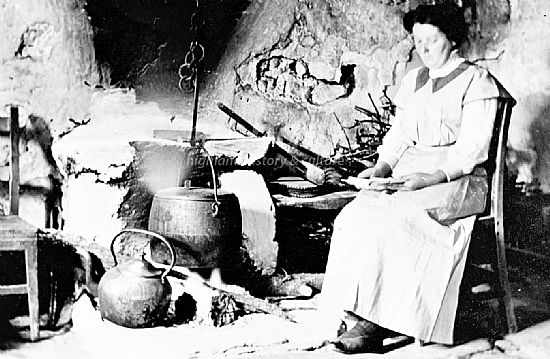Our Cultural Mix
The Scottish Cooking Pot

This photograph of the lady reading whilst the pot is boiling comes from the Isabel F. Grant Collection in the Scottish Library in Edinburgh but was supplied by Am Baille.
The pot is suspended over the fire on a long, adjustable chain from the ceiling.
Isabel Grant spent her life collecting tools, pictures and information about a Highland way of life that was fast disappearing. Much of her work is on display in The Highland Folk Museum in Newtonmore.
The photo is somewhat posed rather than a historic snap shot. However it provides a handy visual metaphor of the way our different cultures can behave when “cooked” together.
One thing that becomes abundantly clear from any wider study of migrations is how mixed up all our cultural backgrounds are.
Scotch Broth or Porridge?
A broth mix of dried lentils, split peas and barley all need to be well soaked overnight before being added to the fresh vegetables but when cooked together the elements remain recognisably distinct. In porridge the oatmeal similarly needs to be soaked so that it can absorb the water but the two elements blend completely thereafter.
Use of the term “cultures” is an attempt to avoid using “races” or appealing to “genetics” which can be so abused in our assessments of human value.
“Cultures” can also be labelled “inferior” or “superior”, of course, but the term itself is rather less loaded with value judgements and also more difficult to define within rigid boundaries.
Some see cultural diversity as a threat and try to absorb migrants and to suppress differences. Others see differences as an enrichment of society. Most of us compromise somewhere in between these extremes.
Picts, Scots, Celts, Romans, Vikings and Anglo-Saxons are seen as subgroups of European (and beyond) peoples with distinctive though inter-related cultures. None were “pure” races.
Rome had itself been invaded by Celtic tribes and Roman generals tended to recruit soldiers and wives from the countries they had conquered in order to expand their empire further.
The “French” who came from the North West regions of France were actually Normans and Bretons.
The Normans got their name because they were Norsemen who had settled in that part of France.
The Flemings who joined them also shared this Norse heritage.
The Bretons were Brythonic peoples, many of whom had migrated from the West of Britain. So this was only a "return migration" by later generations.
The mix in our Scottish pot is swirling as it heats up without even needing to be stirred.

“1066 and All That” by W. C. Sellars and R.J. Yeatman, illustrated by John Reynolds, includes a happy satire on the “wave theory” of migration into Britain as it was taught in history lessons at the time. It also pokes gentle fun at the ludicrous assumptions of English greatness at the time. It was written for adults between the Great Wars.
It is fascinating to look for clues about our mixed cultural heritage in languages/dialects, customs, place names and clan origins etc. The Scots have left many such clues of their presence in the countries to which they have spread.
Suggested further reading:
Benedict Anderson: Imagined Communities: Reflections on the Origin and Spread of Nationalism. London (1983)
John D. Skrentny : “Culture and Race/Ethnicity: Bolder, Deeper, and Broader” in The Annals of the American Academy of Political and Social Science Vol. 619, Cultural Sociology and Its Diversity (Sep., 2008), pp. 59-77 Sage Publications Incorporated
Paul Basu: “Macpherson Country: genealogical identities, spatial histories and the Scottish diasporic landscape” Cultural Geographies, Vol. 12, No. 2 (April 2005), pp. 123-150 : Sage Publications

